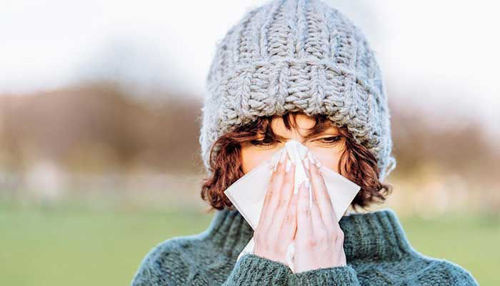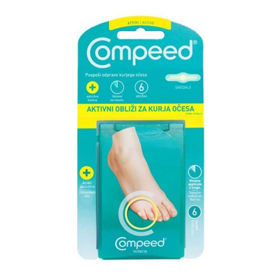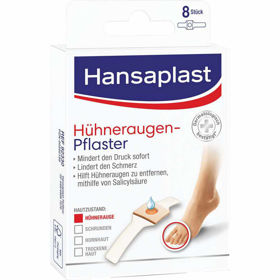A corn or callus is a thick, visibly hardened layer of skin that forms when the skin tries to protect itself from friction or pressure in that area. Such skin formations are often included on the feet. The removal and treatment of corn are not vital; they are only removed if they cause pain when walking or are an aesthetic problem.
SURGE'S EYE or DETROIT: What does it look like? | What is corn? | Causes of occurrence | Preventiva | Comb Removal | Questions and Answers | Sources/references
How does it look?
Pimples are unpleasant-looking skin formations - they can even go away on their own, but usually only if we ease the pressure on the problem area.
To correctly identify the imprint or corns, see the pictures below.

Very often, when recognizing corns, they are mistaken for plantar warts. However, on closer inspection, thin blood vessels can be seen in these.

As a result, this type of wart is often quite different from the treatment of warts.
What is corn? How to recognize it?
Corns or calluses are accumulations of hard, thick patches of skin that most often appear on the feet. Although these hardened areas of skin can form anywhere on the body, you will usually notice them on the feet, less commonly on the hands or fingers. Corns are generally small and round, and you are most likely to see corns on the top or sides of your toes.
There are several versions of corns:
- Hard corns are small, challenging, dense areas of skin, usually within a larger area of thickened skin. Hard grains typically form on the top of the toes - i.e., in the places where the bone presses against the skin.
- Soft Corns: These corns are whitish/grey and have a softer, rubbery texture. These most often appear between the fingers.
- Seed Corns: These corns are small and usually form on the bottom of the feet.
The causes of corn are different.
Corns are caused by repeated friction, rubbing or irritation, and pressure on the skin of a particular area. They usually form on bony or bulging areas of the feet. They also appear on the hands where the skin constantly rubs or is under pressure.
Video content: causes of corns and calluses on the leg.

The hardened skin layers of corn are your body's way of protecting the active skin layer from irritation and pressure.
The probability that corn will appear is higher if:
- You have medical problems that change the normal alignment of the bones in your feet. For example, arthritis in the feet, bunions, bone spurs, or hammertoes
- Walk without socks
- Wear shoes that are too narrow for your foot
- Smoke cigarettes
- You stand, walk or run for a long time
- You regularly engage in physical hobbies, sports, or work that puts pressure on your feet.
- Walk barefoot
- Walk with an incorrect posture - improper walking on the inner or outer edge of the foot.
- You regularly engage in physical hobbies, sports, or work that causes repetitive friction and pressure.
- You are dealing with a structural deformity of the feet or altered biomechanics.
Identify corns
Common symptoms include:
- Hardened areas of the skin where there is repeated friction or pressure on the skin.
- A small, round, raised bump of hardened skin surrounded by irritated skin.
- Thick, hardened, larger, usually flatter part of the skin.
Video content: symptoms and the possibility of removing the imprint

- Less sensitive to the touch than the surrounding skin.
- The raised area of the bump may be painful or uncomfortable.
- Pain, redness, blisters.
How are corns diagnosed?
Cores and corns are not difficult to diagnose. No special tests are required. A simple visual inspection of the skin is usually required. Your doctor may ask you about your job, how much you walk and stand, and what activities you participate in. If you have corn on your feet, your doctor may ask you to walk to check your posture and gait and ask about your footwear and how you care for your feet.
Take preventive measures against the appearance of corn
The feet are an often overlooked body part until a problem arises. With a bit of attention and care, most cases of corn can be prevented.
Advice that makes sense to follow:
- Wear shoes that are comfortable and fit well. Shoes should support your feet, be well-cushioned, and have shock-absorbing soles. The toes of the shoes should be long and wide enough so that your toes do not rub against the walls of the shoe or other toes. This would also mean avoiding shoes with high heels and narrow toes that push the toes forward, causing them to rub against the shoe or each other. Avoid shoes with rugged or leather soles unless they have enough cushioning (or you add cushioning) to soften your feet.
- Wear socks with your shoes. Please ensure the socks are tight enough so they don't sag under your feet.
- Use cushioned or padded insoles in your footwear. If you have had corns or corns in the past, talk to your doctor about customized insoles. These insoles can balance the load forces on the lower part of the foot and thus prevent the formation of corns, calluses, and calluses. Also, use lamb's wool (not cotton) between your toes to reduce friction and soften the corn.
Video content: how to take preventive measures and prevent redness?

- Wear gloves. Wear suitable gloves when doing physical work or working with heavy or rough materials that can damage the skin on your hands or fingers.
- Examine your feet every day and keep them clean. Wash your feet in warm soapy water, dry them and apply a foot moisturizer. This helps keep your skin soft and supple.
- Cut the toenails to a suitable length.
- Don't walk barefoot.
- Apply foot powder daily to dry your feet (if you have sweaty feet).
Corn Removal
Most corn can be removed by following simple care tips. However, surgery is considered in cases of structural deformities of the feet or toes, which cause repeated development of corns. The surgeon may also need to remove or realign the bone tissue in this case. Other reasons for surgery are if there are corns that are very painful or if they prevent you from walking comfortably or normally.
Video content: corns removal.

A surgeon, usually a podiatrist, uses a scalpel to cut away the thickened skin or to cut out giant corn. We recommend that you do not attempt this yourself, as doing so may result in infection or a possible cut.
The pedicurist can also use a patch containing 40% salicylic acid to improve the treatment results. Such patches are sold without a prescription in a pharmacy and can be used as part of self-care for corn. Your pharmacist will tell you how often you will change this patch; between applications of this patch, try to thin the thickened skin with a porous pumice stone, a nail file, or an emery board before applying a new patch.
Some tips for home care and corns removal:
- Soak the area of the corn in warm water until the skin softens – usually 5 to 10 minutes.
- Soak the pumice aland emery board.
- While the skin on your foot is still soft, gently move a pumice stone or emery file over the corn to remove dead tissue. Continue to file the corn's eye, forcing the stone or tile in one direction. Be careful not to remove too much skin, as this can lead to bleeding and infection.
- Apply a moisturizing cream or lotion daily to the corn and surrounding dead skin. Look for and choose products that contain urea, salicylic acid, or ammonium lactate. These ingredients will eventually soften the skin.
Questions and answers
Can corn be dangerous?
Calluses or corns are usually not harmful, but sometimes they can cause irritation, infection, or ulcers on the skin, especially in people with diabetes or poor circulation in the feet.
Can corns come back after removal?
Since corn is caused by friction, irritation, or pressure on the skin, it can return at any time if the cause is not addressed. In other words, if the cause of their formation was perhaps ill-fitting shoes and the footwear is not adjusted, corns or most likely returned by the natives.
Fortunately, most corn can be cured at home with care and attention. However, if you are ever concerned about a growth on your foot or perhaps unsure of what to do or how to treat it, especially if you have diabetes, are prone to infections, or have sensitive skin, see your doctor. Your doctor will help you with advice, and at the same time, he will examine your feet, ask questions, or test for other health problems that you may have that are even related to the formation of corns.
How to get rid of corn on the foot?
Soaking corn in warm water and cleaning them with soap is the correct way to solve this problem - the soft skin makes it easier to remove the thickened skin of the corn.
Video content: easy ways to remove corns.

After softening the affected skin, rub the corns with a callus file[1].
What does a corn or an imprint look like?
You may have corns on your feet if you notice the following symptoms on the tips and sides of your toes: rough, tough, yellow-spotted lumps and possibly uneven skin that is sensitive to the touch and painful when wearing shoes[2]< /sup>.
What is inside the print?
At the center of corn, there is often a thick, compact skin called the pith, located above the most excellent friction or pressure area. Hard, dry corns on the upper surfaces of the toes are called hard corns. Flexible, moist corns that form between the toes are called soft corns[3].
Sources and references
1. Corns and calluses - ttps://www.mayoclinic.org
2. Treating and Preventing Foot Corns - https://www.healthline.com
3. Calluses and corns - https://www.health.harvard.edu












 Facebook
Facebook
 Instagram
Instagram
 info@moja-lekarna.com
info@moja-lekarna.com

